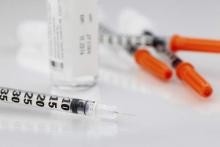STOCKHOLM – In patients with type 1 diabetes, treatment with the long-acting basal insulin peglispro conferred lower hemoglobin A1c with fewer episodes of nocturnal hypoglycemia – and a bonus weight loss to boot.
“To the best of my knowledge, no registry study of any insulin analogue has ever showed that it is not only noninferior, but [also] actually better than the corresponding molecule,” said Dr. Satish K. Garg, chief of the young adult clinics at the Barbara Davis Center for Diabetes, Aurora, Colo.
The significant benefits came with some downsides, though Dr. Garg said they were neither surprising nor serious. PEGylated basal insulin lispro (BIL), which is expected to come up for review with the Food and Drug Administration in 2016, acts preferentially in the liver; patients who took it experienced increases in triglycerides and alanine aminotransferase. Some also showed a slight increase in liver fat content, although the numbers were very close to the high end of normal.
Dr. Garg presented results from Eli Lilly’s open-label IMAGINE 1 study, which randomized 455 patients with type 1 diabetes to either BIL or insulin glargine (GL) alone for 78 weeks. The primary endpoint – noninferiority of BIL as demonstrated by HbA1c – was collected at 26 weeks. Secondary endpoints included weight loss, total and nocturnal hypoglycemia, lipid measurements, and liver safety.
A subset of these patients, along with some from the double-blind IMAGINE 3 study, underwent liver fat measurements by MRI (182 patients).
The cohort was a typical one. Patients were a mean of 40 years old, with disease duration of about 16 years. Their body mass index was not excessive (25 kg/m2); this reflected a multinational cohort, which included patients in Asia. The baseline HbA1c was 7.9%; about 20% were below 7%.
They were randomized to bedtime BIL or insulin glargine (GL) with prandial insulin lispro. Most patients had been taking glargine as their baseline insulin (70%). Other baseline treatments were insulin detemir (16%) and NPH insulin (10%); the remainder used a pump.
At 26 weeks, HbA1c levels were significantly lower in those taking BIL than GL (7% vs. 7.4%). The measurements began to separate around week 13, and the curves remained significantly different throughout the end of the study.
Fasting serum glucose was also significantly lower among those taking BIL at 26 weeks (7.7 mmol/L vs. 8.9 mmol/L). Again, the curves separated significantly by 13 weeks and continued to do so until the study’s end.
Overall, BIL was associated with significantly more hypoglycemic events (16 vs. 12 events per patient/30 days). But those taking BIL reported significantly fewer nocturnal events (3 vs. 2 per patient/30 days).
BIL was also associated with significantly more episodes of severe hypoglycemia in both IMAGINE 1 and 3. At 26 weeks in IMAGINE 1, severe hypoglycemia was almost twice as common in the BIL group as in the GL group (11.3% vs. 5.7%). The proportion was similar at 78 weeks (15% vs. 8.2%). The rate per 100 patient-years in IMAGINE 1 was also significantly higher with BIL (23 vs. 9). In IMAGINE 3, however, the event rate associated with BIL was lower than it was with GL (19 vs. 22 per 100 patient/years; P = .445). Most of the episodes (68%) occurred within 5 hours of talking an insulin bolus, Dr. Garg noted.
Patients taking BIL also lost weight during the first half of the study, while those taking GL gained. By week 26, those taking the study drug had dropped a mean of 1.2 kg; those in the control group had gained about 0.8 kg. That difference was maintained throughput the study, although patients taking BIL did tend to gain a bit of weight in the last 8 weeks (about 0.25 kg).
Low- and high-density lipoproteins remained unchanged in both arms, but triglycerides increased significantly more in the BIL group than in the GL group (a mean of 1.3 vs 1.0 mmol/L ).
Alanine aminotransferase was the only liver enzyme affected. It increased significantly by week 13 and remained elevated the entire study, reaching about 28 U/L by week 78, compared with about 20 U/L for those taking GL.
Liver fat content was higher in the BIL group throughout the study, rising from 3% at baseline to 6% at week 78. The upper limit of normal MRI is 5.56%, Dr. Garg noted. Liver fat was unchanged in patients taking GL.
In both IMAGINE 1 and 3, there were more injection-site reactions in the BIL group (IMAGINE 1, 25% vs. 0%; IMAGINE 3, 13% vs. 0.2%). Lipohypertrophy also was more common in both IMAGINE 1 (15% vs. 0%) and IMAGINE 3 3 (7.7% vs. 0.2%).


